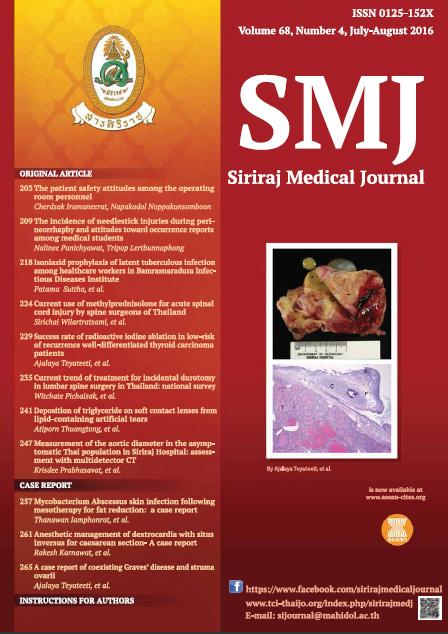The Incidence of Needlestick Injuries During Perineorrhaphy and Attitudes Toward Occurrence Reports Among Medical Students
Keywords:
Medical students, needlestick injury, perineorrhaphyAbstract
Background: Medical students are at risk of needlestick injuries (NSIs) while performing obstetrical procedures especially perineorrhaphy, because of their less experience. This study aims to determine the incidence and causes of NSIs during perineorrhaphy and medical students’ attitudes toward occurrence reports.
Methods: A cross-sectional study was conducted. After completion of Obstetrics & Gynaecology rotation, the data from final year medical students were collected using a self-administered questionnaire.
Results: Of 390 medical students, 290 (74.4%) returned questionnaires with complete data. The annual NSIs incidence during episiotomy was 26.9%. The most common site of injury was the index finger of the non-dominant hand (66.2%). Common causes of NSIs were time pressure (52.1%) and lack of surgical skills (50.7%). Nearly half of students (41%) did not report their occurrence, and 81.3% of injured students believed that NSIs were harmless.
Conclusion: The incidence of NSIs during perineorrhaphy and the non-reporting occurrence were quite high among medical students. Structural clinical supervision by medical staffs, HBV vaccination for all medical students, and instruction on standard pre-exposure precaution should be applied. We advocate a strategy plan for increasing students’ awareness and having a simple occurrence reporting system for NSIs, with clear guidelines on post-exposure protocols in all medical schools and teaching hospitals.
Downloads
Published
How to Cite
Issue
Section
License
Authors who publish with this journal agree to the following conditions:
Copyright Transfer
In submitting a manuscript, the authors acknowledge that the work will become the copyrighted property of Siriraj Medical Journal upon publication.
License
Articles are licensed under a Creative Commons Attribution-NonCommercial-NoDerivatives 4.0 International License (CC BY-NC-ND 4.0). This license allows for the sharing of the work for non-commercial purposes with proper attribution to the authors and the journal. However, it does not permit modifications or the creation of derivative works.
Sharing and Access
Authors are encouraged to share their article on their personal or institutional websites and through other non-commercial platforms. Doing so can increase readership and citations.











